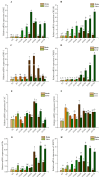Mitigating Effect of Taurine Combined with Corona Dormancy on Oxidative Stress in Trachinotus ovatus Under Low-Temperature Stress
- PMID: 40243503
- PMCID: PMC11989161
- DOI: 10.3390/ijms26072927
Mitigating Effect of Taurine Combined with Corona Dormancy on Oxidative Stress in Trachinotus ovatus Under Low-Temperature Stress
Abstract
The purpose of the present work was to establish the transportation conditions for keeping Trachinotus ovatus alive by means of corona-induced dormancy in combination with taurine. It also investigated the synergistic regulatory effects on oxidative stress mitigation and immune function during low-temperature conditions and clarified the underlying mechanism. The dormancy pretreatment induced by pulsed direct current could reduce the accumulation of reactive oxygen species in fish under hypothermal and water-restricted conditions and significantly enhance the environmental adaptability of Trachinotus ovatus. The survival period and survival rate of Trachinotus ovatus were significantly increased when combined with taurine at a concentration of 70 mg/L, and the activities of enzymes related to oxidative stress also increased significantly, including catalase, superoxide dismutase (SOD), glutathione S-transferase, and so on. The underlying mechanism involved the upregulation of mRNA expression in the Nrf2/Keap1 pathway components. Furthermore, taurine supplementation was found to bolster the immune function of Trachinotus ovatus. Histological examinations revealed that taurine exerted protective effects on the ultrastructural integrity of the liver and gills, which were susceptible to stress-induced damage during transportation. Altogether, the concerted action of corona dormancy and taurine significantly mitigated the stress responses and tissue injuries of fish during low-temperature live transportation, thereby providing a mechanistic basis for the enhancement of live fish transportation techniques.
Keywords: Trachinotus ovatus; corona dormancy; live transportation; oxidative stress; taurine.
Conflict of interest statement
The authors declare that they have no known competing financial interests or personal relationships that could have appeared to influence the work reported in this paper.
Figures






Similar articles
-
Effects of exogenous taurine supplementation on the growth, antioxidant capacity, intestine immunity, and resistance against Streptococcus agalactiae in juvenile golden pompano (Trachinotus ovatus) fed with a low-fishmeal diet.Front Immunol. 2022 Oct 14;13:1036821. doi: 10.3389/fimmu.2022.1036821. eCollection 2022. Front Immunol. 2022. PMID: 36311806 Free PMC article.
-
Liver transcriptome analysis reveal the metabolic and apoptotic responses of Trachinotus ovatus under acute cold stress.Fish Shellfish Immunol. 2024 May;148:109476. doi: 10.1016/j.fsi.2024.109476. Epub 2024 Mar 4. Fish Shellfish Immunol. 2024. PMID: 38447780
-
Effects of acute ammonia exposure and recovery on the antioxidant response and expression of genes in the Nrf2-Keap1 signaling pathway in the juvenile golden pompano (Trachinotus ovatus).Aquat Toxicol. 2021 Nov;240:105969. doi: 10.1016/j.aquatox.2021.105969. Epub 2021 Sep 24. Aquat Toxicol. 2021. PMID: 34600396
-
Identification of heme oxygenase-1 from golden pompano (Trachinotus ovatus) and response of Nrf2/HO-1 signaling pathway to copper-induced oxidative stress.Chemosphere. 2020 Aug;253:126654. doi: 10.1016/j.chemosphere.2020.126654. Epub 2020 Apr 8. Chemosphere. 2020. PMID: 32464761
-
Taurine and oxidative stress in retinal health and disease.CNS Neurosci Ther. 2021 Apr;27(4):403-412. doi: 10.1111/cns.13610. Epub 2021 Feb 23. CNS Neurosci Ther. 2021. PMID: 33621439 Free PMC article. Review.
References
-
- Zhou C.P., Ge X.P., Niu J., Jin H.Z., Huang Z., Tan X.H. Effect of dietary carbohydrate levels on growth performance, body composition, intestinal and hepatic enzyme activities, and growth hormone gene expression of juvenile golden pompano, Trachinotus ovatus. Aquaculture. 2015;437:390–397. doi: 10.1016/j.aquaculture.2014.12.016. - DOI
-
- Ke C.L., Liu Q., Li L., Chen J.W., Zhao C.H., Xu J.P., Huang K., Song M.M., Li L.D. Residual levels and risk assessment of eugenol and its isomers in fish from China markets. Aquaculture. 2018;484:338–342. doi: 10.1016/j.aquaculture.2017.07.034. - DOI
-
- Zhang Y.J., Wang W.S., Yan L., Glamuzina B., Zhang X.S. Development and evaluation of an intelligent traceability system for waterless live fish transportation. Food Control. 2019;95:283–297. doi: 10.1016/j.foodcont.2018.08.018. - DOI
-
- Yang Z.Y., Li S., Chen B., Kang H.Y., Hang M.H. China’s aquatic product processing industry: Policy evolution and economic performance. Trends Food Sci. Technol. 2016;58:149–154. doi: 10.1016/j.tifs.2016.09.004. - DOI
-
- Fan X.P., Qin X.M., Zhang C.H., Zhu Q.F., Chen J.P., Chen P.W. Metabolic and anti-oxidative stress responses to low temperatures during the waterless preservation of the hybrid grouper (Epinephelus fuscogutatus♀ × Epinephelus lanceolatus♂) Aquaculture. 2019;508:10–18. doi: 10.1016/j.aquaculture.2019.04.054. - DOI
MeSH terms
Substances
Grants and funding
- (2019YFD0901601)/the key special project of "Blue Granary Science and Technology Innovation" in the national key research and development plan during the "13th Five-Year Plan" period
- (2021A1515110621)/the Guangdong Basic and Applied Basic Research Foundation Project
- (2021E05017)/the Zhanjiang Science and Technology Plan Project
LinkOut - more resources
Full Text Sources

